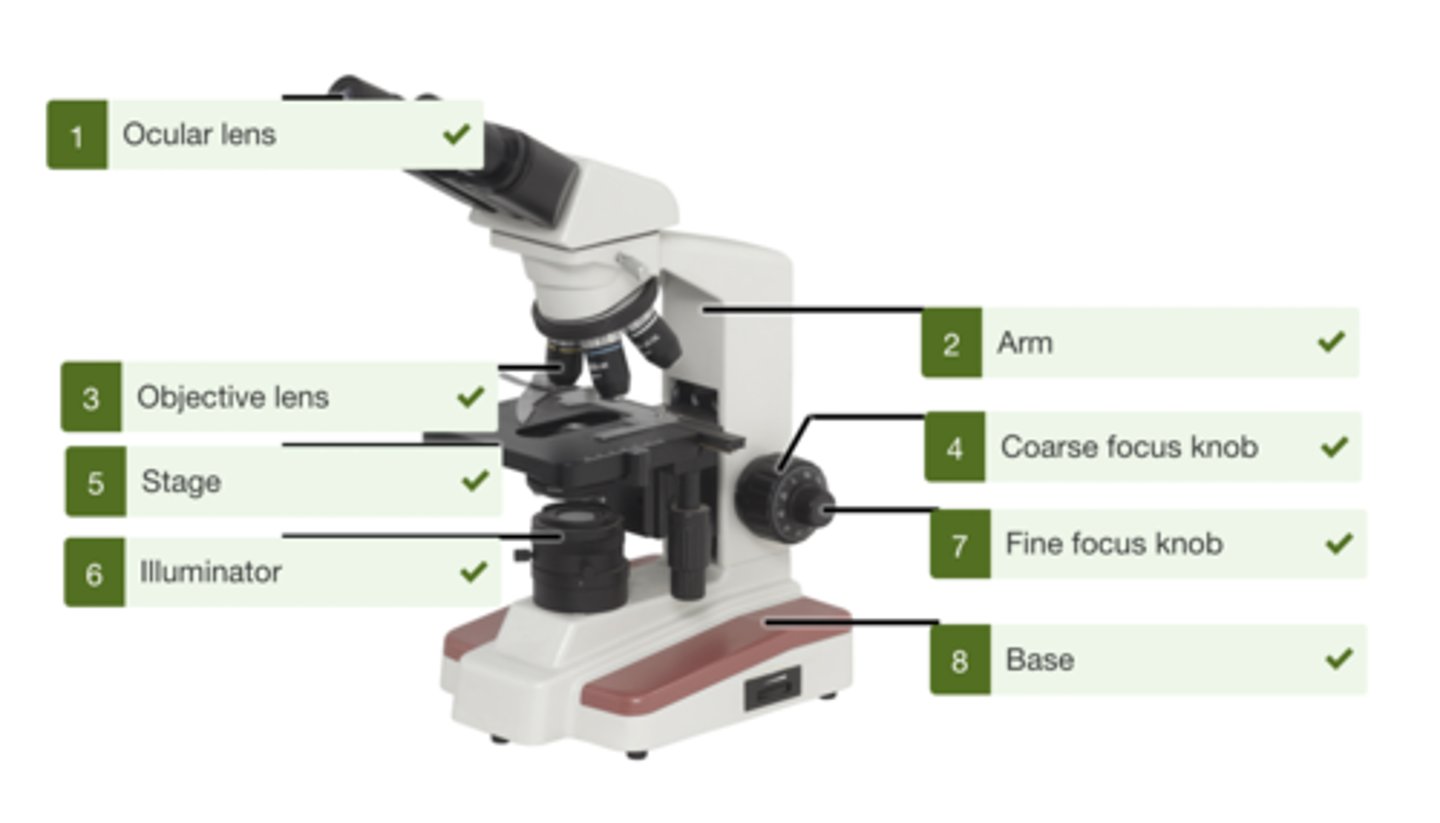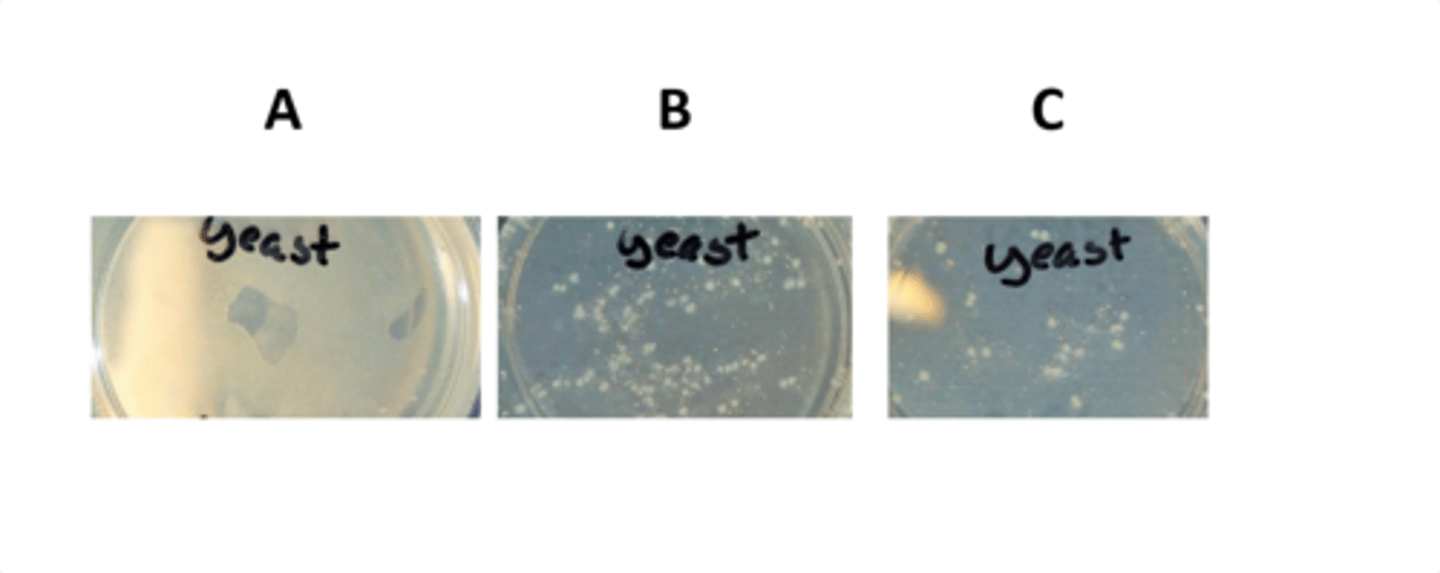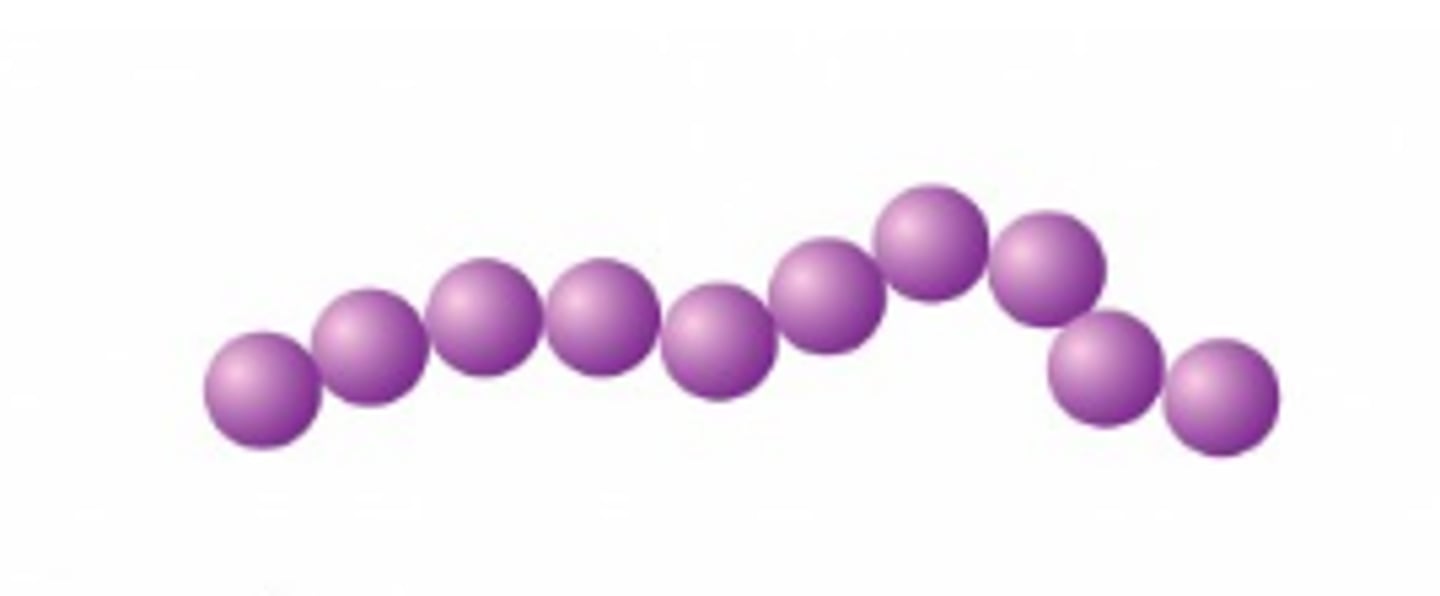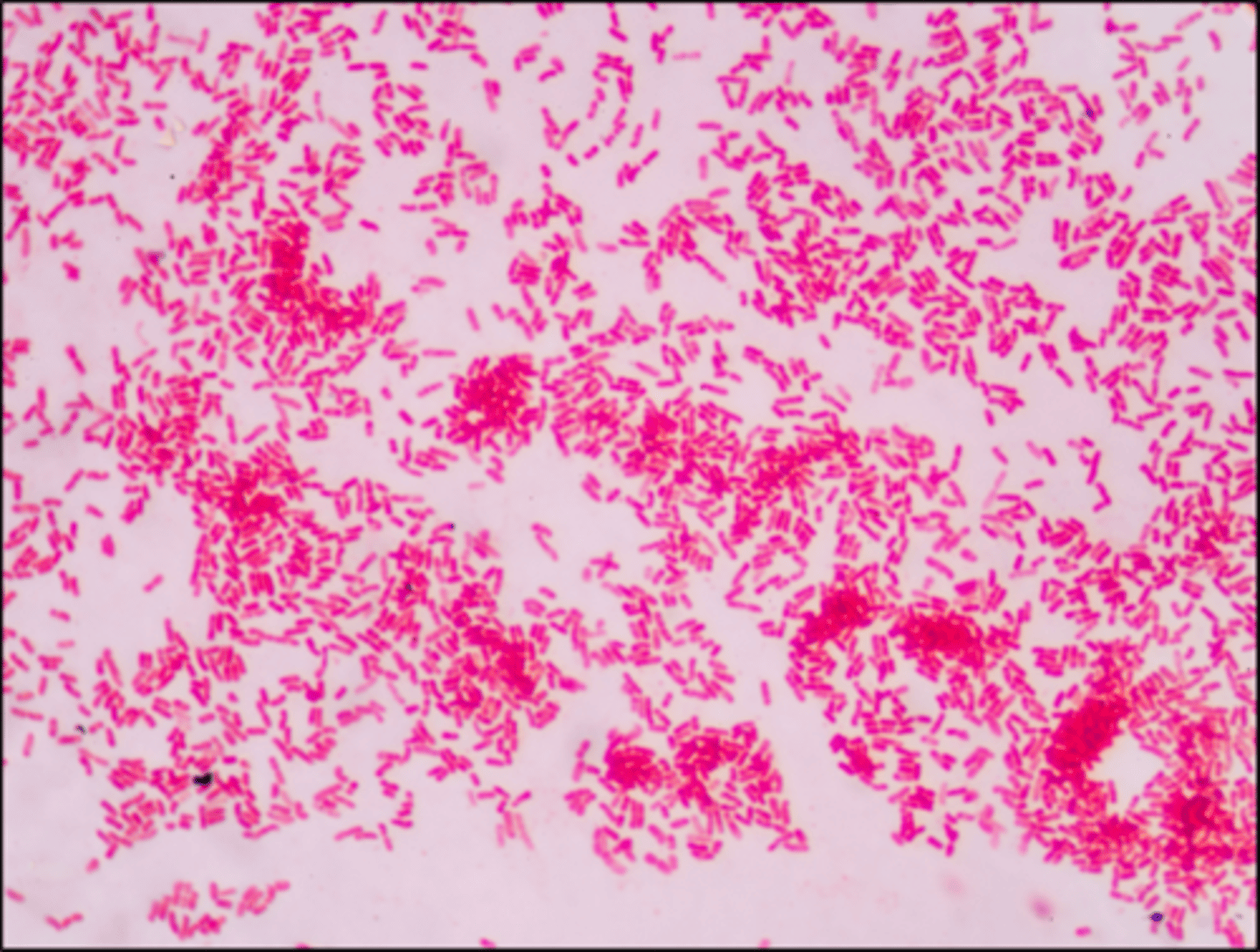Microbiology Lab Final - Multiple choice questions
1/211
There's no tags or description
Looks like no tags are added yet.
Name | Mastery | Learn | Test | Matching | Spaced |
|---|
No study sessions yet.
212 Terms
Ocular Lens
-Calculated by multiplying the magnification of the ocular lens with the objective lens
-Visible area of a slide that can be observed
-Eye piece that is typically 10X or 15X magnification
-Distance range that is in focus at a given time
-Held by the turret closest to the stage, and range in power from 4x to 100x magnification
Eye piece that is typically 10X or 15X magnification
Total Magnification Factor
-Calculated by multiplying the magnification of the ocular lens with the objective lens
-Visible area of a slide that can be observed
-Eye piece that is typically 10X or 15X magnification
-Distance range that is in focus at a given time
-Held by the turret closest to the stage, and range in power from 4x to 100x magnification
Calculated by multiplying the magnification of the ocular lens with the objective lens
Field of View
-Calculated by multiplying the magnification of the ocular lens with the objective lens
-Visible area of a slide that can be observed
-Eye piece that is typically 10X or 15X magnification
-Distance range that is in focus at a given time
-Held by the turret closest to the stage, and range in power from 4x to 100x magnification
Visible area of a slide that can be observed
Depth of Field
-Calculated by multiplying the magnification of the ocular lens with the objective lens
-Visible area of a slide that can be observed
-Eye piece that is typically 10X or 15X magnification
-Distance range that is in focus at a given time
-Held by the turret closest to the stage, and range in power from 4x to 100x magnification
Distance range that is in focus at a given time
Objective Lens
-Calculated by multiplying the magnification of the ocular lens with the objective lens
-Visible area of a slide that can be observed
-Eye piece that is typically 10X or 15X magnification
-Distance range that is in focus at a given time
-Held by the turret closest to the stage, and range in power from 4x to 100x magnification
Held by the turret closest to the stage, and range in power from 4x to 100x magnification
Label The Microscope
-Ocular Lens
-Arm
-Objective Lens
-Coarse Focus Knob
-Stage
-Illuminator
-Fine Focus Knob
-Base

A compound microscope is a type of optical microscope. - T/F
True
The _____ sits below the stage and varies the field for viewing the specimen.
-diaphragm
-coarse adjustment knob
-base
-None of the above
diaphragm
The depth of field is independent of the total magnification factor. - T/F
False - Like field of view, the depth of field is dependent on the total magnification factor.
The main component of an optical microscope that is used to focus an image at a high power of magnification is the _____.
-coarse adjustment knob
-diaphragm
-fine adjustment knob
-None of the above
fine adjustment knob
The slide is placed on the _____ of an optical microscope.
-stage
-turret
-base
-None of the above
stage
Depth of field refers to the distance range that is in focus at a given time. - T/F
True
When calculating total magnification of a microscope, both the ocular lens and the objective lens should be considered. - T/F
True
The oil immersion lens provides optimal viewing of large specimens. - T/F
False - The oil immersion lens provides optimal viewing of small specimens.
If the magnification of a compound microscope is increased from 10x to 100x, the field of view will _____.
-decrease
-increase by 10x
-increase by 100x
-None of the above
decrease
When creating a wet-mount slide, an individual should drop the cover slip on the top of a water droplet placed on the slide without touching it to the slide first. - T/F
False - One edge of the cover slip should be touching the slide before it is dropped onto the water droplet.
Aseptic techniques are designed to prevent the spread of microorganisms beyond the intended working environment. T/F
True
media containers should be stored away from children and pets. T/F
True
Open tubes and vials should be tilted away from the mouth and nose. T/F
True
Plates should be incubated agar side down. T/F
False
The caps and lids of media containers should be placed on countertops when working with cultures. T/F
False
work surfaces should be sterilized with soap and water. T/F
False
Broth
-Liquid media used to increase the number of microorganisms.
-Normal flora bacteria used for studies involving osmotic pressure, antibiotic resistance, and biofilms.
-Instrument used for spreading microorganisms across a streak plate.
-Solid media used to isolate microbes.
-Clump of genetically identical microorganisms.
-Single-celled fungi used for studies involving fermentation, genetics, and aging.
Liquid media used to increase the number of microorganisms.
Agar Plate
-Liquid media used to increase the number of microorganisms.
-Normal flora bacteria used for studies involving osmotic pressure, antibiotic resistance, and biofilms.
-Instrument used for spreading microorganisms across a streak plate.
-Solid media used to isolate microbes.
-Clump of genetically identical microorganisms.
-Single-celled fungi used for studies involving fermentation, genetics, and aging.
Solid media used to isolate microbes.
Stephylococcus epidermidis
-Liquid media used to increase the number of microorganisms.
-Normal flora bacteria used for studies involving osmotic pressure, antibiotic resistance, and biofilms.
-Instrument used for spreading microorganisms across a streak plate.
-Solid media used to isolate microbes.
-Clump of genetically identical microorganisms.
-Single-celled fungi used for studies involving fermentation, genetics, and aging.
Normal flora bacteria used for studies involving osmotic pressure, antibiotic resistance, and biofilms.
Colony Forming Unit
-Liquid media used to increase the number of microorganisms.
-Normal flora bacteria used for studies involving osmotic pressure, antibiotic resistance, and biofilms.
-Instrument used for spreading microorganisms across a streak plate.
-Solid media used to isolate microbes.
-Clump of genetically identical microorganisms.
-Single-celled fungi used for studies involving fermentation, genetics, and aging.
Clump of genetically identical microorganisms.
Saccharomyces cerevisiae
-Liquid media used to increase the number of microorganisms.
-Normal flora bacteria used for studies involving osmotic pressure, antibiotic resistance, and biofilms.
-Instrument used for spreading microorganisms across a streak plate.
-Solid media used to isolate microbes.
-Clump of genetically identical microorganisms.
-Single-celled fungi used for studies involving fermentation, genetics, and aging.
Single-celled fungi used for studies involving fermentation, genetics, and aging.
Inoculation Loop
-Liquid media used to increase the number of microorganisms.
-Normal flora bacteria used for studies involving osmotic pressure, antibiotic resistance, and biofilms.
-Instrument used for spreading microorganisms across a streak plate.
-Solid media used to isolate microbes.
-Clump of genetically identical microorganisms.
-Single-celled fungi used for studies involving fermentation, genetics, and aging.
Instrument used for spreading microorganisms across a streak plate.
Agar plates should be labeled on the _____.
-lid
-bottom
-side
-All of the above
bottom
Aseptic techniques are necessary to _____.
-maintain safety
-isolate pure cultures
-prevent the spread of unwanted microbes
-All of the above
All of the above
Agar is a solid media used in both slants and plates. - T/F
True
The inoculation loop must be sterilized _____ when creating a streak plate.
-before use
-between use in each quadrant
-after completing all quadrants
-All of the above
All of the above
Morphology can be used to identify microorganisms with or without the use of a microscope. - T/F
True
_____ is a rod-shaped bacteria important to the study of genetics and evolution.
-Escherichia coli
-Saccharomyces cerevisiae
-Staphylococcus epidermidis
-All of the above
Escherichia coli
Aseptic technique includes _____ .
-working quickly and efficiently around open media containers
-not talking or breathing over open media containers
-washing hands before and after working with media
-All of the above
All of the above
All equipment and work surfaces should be cleaned with a bleach solution after contacting microbe cultures. T/F
True
Tryptic Soy Agar (TSA) is a _____ media.
-general purpose liquid
-selective liquid
-general purpose solid
-None of the above
general purpose solid
Streak plating is performed by pouring broth onto agar plates. T/F
False - Streak plating is performed by spreading a bacterial sample on the surface of an agar plate with an inoculation loop.
_____ is a common, harmless microbe used in laboratory studies.
-Escherichia coli
-Saccharomyces cerevisiae
-Staphylococcus epidermidis
-All of the above
All of the above
When transferring microbes from a broth to a plate, the inoculation loop should be sterilized _____.
-before placing in broth
-after spreading microbes on the agar surface
-prior to disposal
-All of the above
All of the above
Turbidity and flocculence are indicators of microbial growth in liquid media. T/F
True
A pure plated culture should exhibit colony forming units with two or more morphologies. T/F
False - A pure culture will produce colonies with identical morphologies.
Colony Forming Unit
-Describes individual colonies on a plate's surface
-Asexual reproduction resulting in two daughter cells
-Cloudiness of a fluid caused by large numbers of particles/organisms
-The number of individuals doubles each generation
-The measure of the light intensity absorbed by a sample
Describes individual colonies on a plate's surface
Exponential Growth
-Describes individual colonies on a plate's surface
-Asexual reproduction resulting in two daughter cells
-Cloudiness of a fluid caused by large numbers of particles/organisms
-The number of individuals doubles each generation
-The measure of the light intensity absorbed by a sample
The number of individuals doubles each generation
Turbidity
-Describes individual colonies on a plate's surface
-Asexual reproduction resulting in two daughter cells
-Cloudiness of a fluid caused by large numbers of particles/organisms
-The number of individuals doubles each generation
-The measure of the light intensity absorbed by a sample
Cloudiness of a fluid caused by large numbers of particles/organisms
Absorbance
-Describes individual colonies on a plate's surface
-Asexual reproduction resulting in two daughter cells
-Cloudiness of a fluid caused by large numbers of particles/organisms
-The number of individuals doubles each generation
-The measure of the light intensity absorbed by a sample
The measure of the light intensity absorbed by a sample
Binary Fission
-Describes individual colonies on a plate's surface
-Asexual reproduction resulting in two daughter cells
-Cloudiness of a fluid caused by large numbers of particles/organisms
-The number of individuals doubles each generation
-The measure of the light intensity absorbed by a sample
Asexual reproduction resulting in two daughter cells
Order the steps for performing a dilution series.
-Determine which plate is the countable plate
-calculate the concentration in the original tube
-Determine the dilutions of the dilution tubes (first series of dilutions)
-Determine the dilutions of the dilution tubes (first series of dilutions)
-Determine which plate is the countable plate
-calculate the concentration in the original tube
Binary fission is a method of sexual reproduction where a single cell (parent cell) will split into four cells (daughter cells). T/F
False - Binary fission is a method of asexual reproduction where a single cell will split into two daughter cells.
Plates with _____ colonies per plate are used to calculate CFUs.
-10-30
-30-300
-20-100
-None of the above
-30-300
To determine the number of CFUs in the original culture, the number of colonies on the viable plate is _____ the total dilution factor of that plate.
-added to
-multiplied by
-divided by
-None of the above.
multiplied by
In binary fission, bacterial cells grow _____.
exponentially
linearly
negatively
None of the above
exponentially
When one bacterial cell undergoes binary fission, there will be _____ cells present on the 5th generation.
5
8
16
None of the above
16
A viable plate count is a method of calculating the number of cells in a dilution by the counting the number of _____ on agar plates.
cells
colonies
species
All of the above
colonies
Performing a 1:8 dilution from the original sample 3 times would produce a dilution of _____.
1:24
1:512
1:4096
None of the above
1:512
To create a series of dilutions, an identical volume of stock (undiluted) solution is added to each of the dilution test tubes. T/F
False - Stock (undiluted) solution is added to the first test tube. Solution from the first test tube is then added to the second test tube. Solution from the second test tube is then added to the third.
Plate _____ in the photo below should be used for a viable plate count.
B

A viable plate has a count of 95 colonies produced from 0.125 mL of a 10-4 dilution of the original sample. The original contains _____ CFU/mL.
760
12,000
7,600,000
None of the above
7,600,000
Congo Red
-A spherical bacteria with a diameter of approximately 0.5 µm
-A dye that stains only the cell leaving the background colorless
-Rod-shaped bacterial cells linked to form a chain
-Mesh-like polymer present in bacteria cell walls
-Acidic stain repelled by the cell's surface
Acidic stain repelled by the cell's surface
Peptidoglycan
-A spherical bacteria with a diameter of approximately 0.5 µm
-A dye that stains only the cell leaving the background colorless
-Rod-shaped bacterial cells linked to form a chain
-Mesh-like polymer present in bacteria cell walls
-Acidic stain repelled by the cell's surface
Mesh-like polymer present in bacteria cell walls
Coccus
-A spherical bacteria with a diameter of approximately 0.5 µm
-A dye that stains only the cell leaving the background colorless
-Rod-shaped bacterial cells linked to form a chain
-Mesh-like polymer present in bacteria cell walls
-Acidic stain repelled by the cell's surface
A spherical bacteria with a diameter of approximately 0.5 µm
Streptobacilli
-A spherical bacteria with a diameter of approximately 0.5 µm
-A dye that stains only the cell leaving the background colorless
-Rod-shaped bacterial cells linked to form a chain
-Mesh-like polymer present in bacteria cell walls
-Acidic stain repelled by the cell's surface
Rod-shaped bacterial cells linked to form a chain
Direct Stain
-A spherical bacteria with a diameter of approximately 0.5 µm
-A dye that stains only the cell leaving the background colorless
-Rod-shaped bacterial cells linked to form a chain
-Mesh-like polymer present in bacteria cell walls
-Acidic stain repelled by the cell's surface
A dye that stains only the cell leaving the background colorless
Order the steps of Gram staining into the proper sequence.
--decolorizer dehydrates gram-positive cell walls
-iodine is applied to the slides
-Crystal violet is applied to heat fixed cells
-safranin is applied to the slide
-Crystal violet is applied to heat fixed cells
-iodine is applied to the slides
-decolorizer dehydrates gram-positive cell walls
-safranin is applied to the slide
_____ are rod-shaped bacteria 0.5 - 20 µm in length.
Cocci
Bacilli
Spirillum
All of the above
Bacilli
_____ are bead-like chains of spherical cells.
Tetrads
Staphylococci
Streptococci
None of the above
Streptococci
Negative staining results in a colorless cell on a stained background. T/F
True
_____ is an example of a direct stain.
Crystal violet
Methylene blue
Safranin
All of the above
All of the above
Gram-positive cells have a thick outer cell wall composed of peptidoglycan. T/F
True
_____ washes dyes from Gram-negative bacteria.
Crystal violet
Iodine
Decolorizer
None of the above
Decolorizer
_____ exist only as single cells and do not form clusters or chains.
Bacilli
Cocci
Spirillum
All of the above
Spirillum
The cell arrangement pictured below is _____.
staphylococcus
streptococcus
diplobacillus
None of the above
streptococcus

Differential staining uses two or more dyes to stain structural components of a cell. T/F
True
The charge of _____ determines how dyes interact with bacterial cells during staining.
chromophores
plasma membranes
porins
None of the above
chromophores
_____ stains Gram-negative bacteria pink.
Crystal violet
Iodine
Safranin
All of the above
Safranin
Gram-positive bacteria have an outer cell membrane containing endotoxins. T/F
False - Gram-negative bacteria have an outer cell membrane lacking endotoxins.
Heat fixing is required for the negative staining process. T/F
False - Heat fixing is not used in negative staining, only direct staining.
Slides should be rinsed after applying _____ during the Gram staining process.
crystal violet
iodine
decolorizer
All of the above
All of the above
The image below is a photograph of Gram-negative bacteria. T/F
True

Bactericidal
-Agent that kills bacterial upon exposure.
-Agent that slows the growth of bacteria.
-Agent artificially synthesized or manipulated from other products.
-Agent naturally produced by microorganisms.
Agent that kills bacterial upon exposure.
Antibiotic
-Agent that kills bacterial upon exposure.
-Agent that slows the growth of bacteria.
-Agent artificially synthesized or manipulated from other products.
-Agent naturally produced by microorganisms.
Agent naturally produced by microorganisms.
Bacteriostatic
-Agent that kills bacterial upon exposure.
-Agent that slows the growth of bacteria.
-Agent artificially synthesized or manipulated from other products.
-Agent naturally produced by microorganisms.
Agent that slows the growth of bacteria.
Antimicrobial
-Agent that kills bacterial upon exposure.
-Agent that slows the growth of bacteria.
-Agent artificially synthesized or manipulated from other products.
-Agent naturally produced by microorganisms.
Agent artificially synthesized or manipulated from other products.
Novobiocin
-Targets DNA gyrase, preventing DNA replication within a cell.
-Binds with bacterial ribosomes to prevent cell growth and cell division.
-Disrupts cell wall stability, eventually leading to cell lysis.
Targets DNA gyrase, preventing DNA replication within a cell.
Penicillin
-Targets DNA gyrase, preventing DNA replication within a cell.
-Binds with bacterial ribosomes to prevent cell growth and cell division.
-Disrupts cell wall stability, eventually leading to cell lysis.
Disrupts cell wall stability, eventually leading to cell lysis.
Gentamicin
-Targets DNA gyrase, preventing DNA replication within a cell.
-Binds with bacterial ribosomes to prevent cell growth and cell division.
-Disrupts cell wall stability, eventually leading to cell lysis.
Binds with bacterial ribosomes to prevent cell growth and cell division.
The mold that Alexander Fleming observed preventing bacterial growth was _____.
Aspergillus
Streptococcus pyogenes
Penicillium notatum
None of the above
Penicillium notatum
Many types of bacteria have gained resistance to antimicrobials at an astonishing rate. T/F
True
Penicillin disrupts the formation of bacterial cell walls by inhibiting the formation of _____ cross-links.
porin
protein
peptidoglycan
None of the above
peptidoglycan
Novobiocin is a bacteriostatic, narrow-spectrum antibiotic that targets _____ in some Gram-positive bacteria.
DNA gyrase
RNA primase
Okazaki fragments
None of the above
DNA gyrase
Bacteriostatic antibiotics cause an inhibition of growth rather than cell lysis and death. T/F
True
Gentamicin binds with bacterial _____.
ribosomes
cell walls
mitochondria
All of the above
ribosomes
The effective zone of inhibition is the same for all antibiotics. T/F
False - The diameter of the zone is dependent on the sensitivity of a microorganism to a particular antibiotic and the physical properties of the antibiotic itself.
An antibiotic is a synthetic drug produced in a laboratory. T/F
False - Antibiotics are directly synthesized by a microorganism. In contrast, antimicrobial agents may be derived from synthetic origin.
____ is a genus that produces antibiotics.
Bacillus
Cephalosporium
Streptomyces
All of the above
All of the above
Penicillin is produced by a _____.
bacteria
mold
virus
All of the above
mold
Novobiocin is a bacteriostatic, narrow-spectrum antibiotic. T/F
True
Gentamicin is synthesized by a _____.
Gram-negative bacteria
Gram-positive bacteria
black mold
None of the above
Gram-positive bacteria
Bacteriostatic agents treat infections by _____.
cell wall lysis
inhibiting ribosomal activity
preventing cell division
None of the above
preventing cell division
Resistant bacteria will exhibit a large zone of inhibition during a Kirby-Bauer diffusion test. T/F
False - Resistant bacteria will exhibit no zone of inhibition during a Kirby-Bauer diffusion test.